Bush tomatoes are Australia’s only native group of solanums and are distinct from most common members of the solanum family. Their sweet, richly flavoured fruit is held on deciduous perennial branches, and they grow well in dry, arid conditions unlike most of their South American relatives.
In this article, we’ll look at how to identify the safe varieties, and how to grow Australian bush tomatoes in your own garden.
More...
Family: | Solanaceae |
|---|---|
Genus: | Solanum |
Common Name: | Bush tomatoes |
Location: | Indoor or outdoor |
Type: | Shrub |
Growth: | 40-50cm (height and spread) |
Sun requirements: | Full sun |
Foliage Colour: | Silvery green |
Flower Colour: | Purple, with yellow staminal cones |
Flowering: | Late summer, early spring |
Fruit: | Edible yellow, red, or orange berries |
Maintenance level: | High |
Poisonous for pets: | Toxic to cats and dog |
What are Bush Tomatoes?
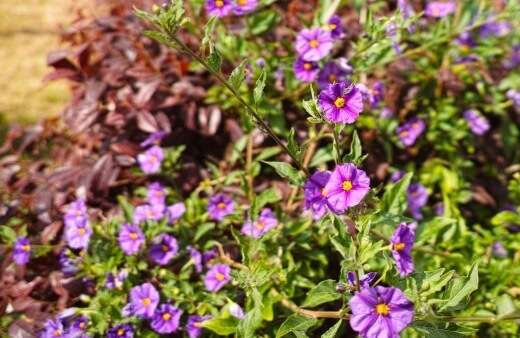
Bush tomatoes are a distinct species in their own right, and unrelated to the determinate bush tomatoes of the Solanum lycopersicum family which are tender perennial plants that only produce fruit for two years even in their native environment.
Native bush tomatoes continue producing fruit for up to ten years, and develop tough woody stems that thrive in arid climates, and grow particularly well after bushfires, which are necessary for germination as smoke is needed to trigger seeds into growth.
There are 94 native species of bush tomato in Australia, but just eight are edible;
- Solanum aviculare (Kangaroo apple)
- Solanum centrale (Desert Raisin)
- Solanum chippendalei (Bush tomato)
- Solanum diversiflorum (Karlumbu)
- Solanum ellipticum (Potato bush)
- Solanum laciniatum (Kangaroo apple)
- Solanum orbiculatum (Round-leaved solanum)
- Solanum phlomoides (Wild tomato)
In this article, we’ll look at how to grow your own, and how to identify the safe-to-eat species in the wild.
Bush Tomato’s Natural Habitat
Bush tomatoes are most commonly found in desert regions of Central Australia. There are 94 species of bush tomato native to Australia, with another 31 species that have been introduced accidentally (though these are mostly annual and struggle to crop as readily in our climate).
Bush tomatoes, regardless of species, thrive in arid desert conditions, on poor soil. In the wild, they fruit for just two months, but with improved irrigation methods, are now cultivated by Aboriginal communities and have fruiting seasons lasting almost eight months.
Edible Varieties of Australian Bush Tomato
There are just eight edible varieties of bush tomato, and while most can be found growing wild in desert regions, just a few are readily available to buy online as seeds for the garden.
Below we’ll look at each type, and clarify the key characteristics of each edible bush tomato species.
Solanum aviculare (Kangaroo Apple)
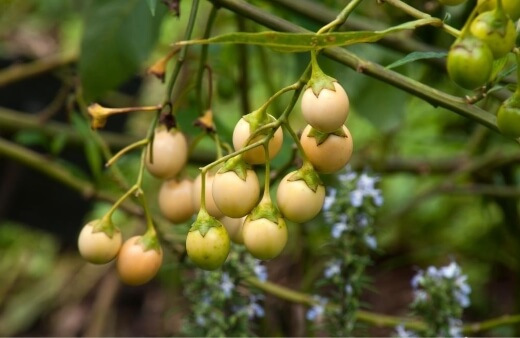
Also called the Kangaroo apple, pam plum or New Zealand Nightshade, this native shrub grows wild throughout New Zealand and along the east coast of Australia.
The entire plant is poisonous, but once the berries ripen and turn orange they are safe to eat and have a rich, sweet melon flavour.
Kangaroo apples have clearly identifiable leaves that grow in lobes, closely resembling kangaroo paws with one central lobe, and two smaller lobes at the base.
Their flowers are blue-purple with faded white stripes along the centre of each petal, but the first identifier of kangaroo apple plants is their size.


Get Your Free Guide:
Master Growing Australian Natives eBook
A Must Have Complete Guide for Every Australian Garden
Get Your Free Guide:
Master Growing Australian Natives eBook
A Must Have Complete Guide for Every Australian Garden
Kangaroo apples grow to 3m tall at maturity, with brittle wooden stems. Fruit ripens irregularly, so you will see green, cream, yellow and orange fruits on the same plant. Only pick fully ripe, dark orange fruits.
Here is our detailed how to grow and care guide for kangaroo apples.
Solanum centrale (Desert Raisin)
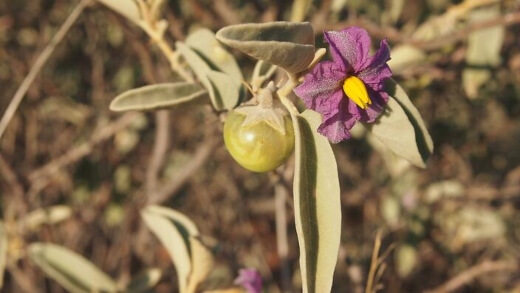
Source: sbs.com.au
The Desert Raisin, or Kutjera plant, is found wild in very arid desert regions and grows following fire followed by heavy rain. You can trigger Desert Raising to germinate at home by exposing them to hot smoke.
The thick leaves grow in symmetrical clusters, beginning with three leaves growing from a growing tip, followed by two more smaller leaves at the base of the cluster, forming a palm shape of curled, folded leaves.
The foliage is a pastel sage colour, with pale margins, and is accompanied by purple flowers with bright yellow staminal cones growing in groups or two or three just below the branch tips.
Young shoots are thick and harden to woody stems in their second year. The fruit ripens to a murky greenish-orange in late summer and is best left on the plant to dry in the sun, which intensifies the flavour and removes any residual toxins.
Solanum chippendalei (Bush Tomato)
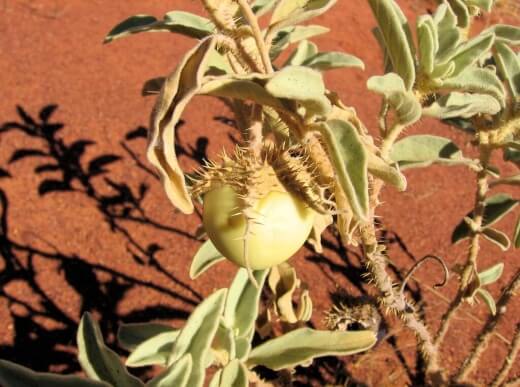
Source: ausemade.com.au
Chippendalei is the most recognisable bush tomato, with frazzled, dry foliage, thin, woody stems, and small green fruits that resemble cherry tomatoes, inside and out.
They do not ripen to red or orange, so should be tested based on touch when they are ready to eat or left to dry on the vine until they resemble sultanas.
The plant itself is hard to differentiate from toxic bush tomatoes and has a typically sage-like habit of growing out from the centre and producing new growth at the end of old dead wood.
The only real way to identify chippendalei is by the sepals, which are spiked and wrap around the tops of each fruit, flowing down from thorned stems.
Do not attempt to forage Solanum chippendalei unless you are a confident forage with experience.
Solanum diversiflorum (Karlumbu)
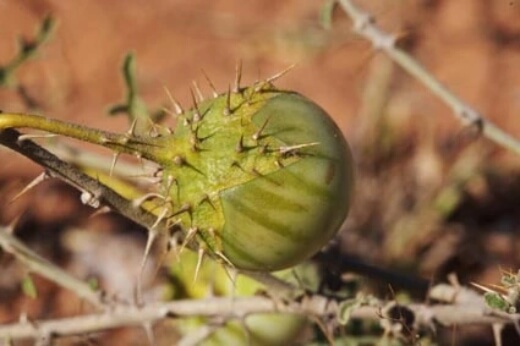
Source: skipas.wordpress.com
Solanum diversiflorum has easily identifiable thistle-like foliage, and striped green fruit with a beautiful marbling from deep emerald to grassy green when ripe.
Like S. chippendalei the sepals are thorny and hang from dry woody stems, with 1cm thorns that tend to grow in pairs on either side of the stem.
When the fruit is soft to the touch, and the marbling across the skin has become darker it is safe to eat, but the flavour is at its best when the whole fruit is sun-dried.
If you wanted to grow edible bush tucker at home, the seeds of S. diversiflorum are hard to come by, but the plants are spectacular, with a sprawling pale green leaf, that is uniquely lobed giving a light, airy texture to the whole plant, which works beautifully in dry, sunny, rockeries, or free-draining sandy soil.
Solanum ellipticum (Potato Bush)
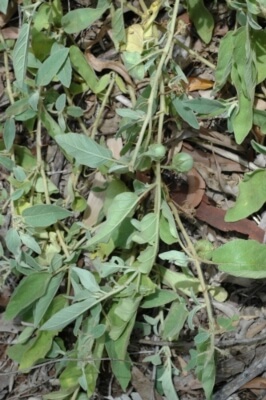
Source: delta-intkey.com
Large purple and pink flowers with deep amber coloured staminal spikes are the fastest way to identify Solanum ellipticum, but the leaves have a unique colouring too.
The bluish-green foliage is arranged in threes, with one larger pointed lead, accompanied by two leaves growing opposite each other about 1cm from the base of the larger leaf.
As the plant matures through the season, small pairs of leaves develop beneath flowers that burst out in small groups at a leaf node.
The plant is usually only 1m tall at maturity and will have a straggly hollow centre filled with dry foliage and dead wood. As fruits ripen they remain green but develop a brown discolouration beneath the sepal at the top.
If you have grown potatoes before and allowed them to go to seed, the fruit is almost identical, hence its common name, ‘potato bush’.
Solanum laciniatum (Kangaroo Apple)
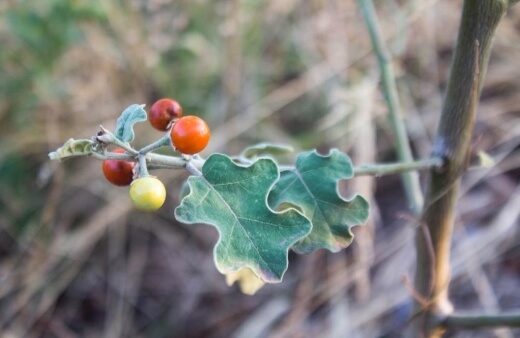
Solanum laciniatum has a much more delicate growth habit than most bush tomatoes or standard tomatoes for that matter. Its elongated, willowy foliage droops from its long slender green stems, which often have a purplish hue on dry ground.
The deep purple flowers are around 4cm across, and the small fruits hand like teardrops from delicate stems, usually hosting around sic fruits per vine. As fruits ripen they turn bright red, like cherry tomatoes, but with a tougher flesh.
Thanks to their decorative properties, and reliable perennial habit, they are quite easy to find online as seeds or young plants and look wonderful in mixed borders.
Solanum orbiculatum (Round-leaved Solanum)
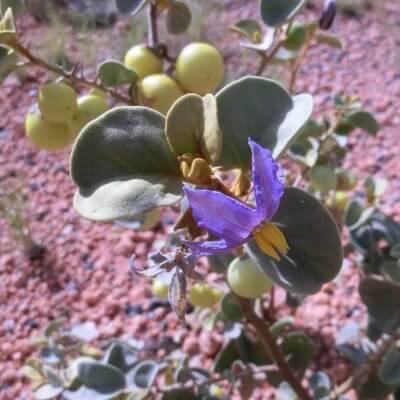
Source: australianseed.com
The round-leaved solanum, Solanum orbiculatum, has powdery white leaves which help it to cope with direct heat and high temperatures in desert conditions.
The foliage has a soft, fluffy texture and will often turn golden-yellow after prolonged droughts, looking and acting very like eucalyptus in many senses.
The purple petals of the flower are pinned backwards, leaving exposed yellow anthers which are easily pollinated by native bees. As the fruit ripens it changes from pale, marbled green to a creamy yellow.
The fruit of these unique solanums is distinctly bitter when eaten fresh, but develops a rich, tangy sweetness when dried.
Solanum phlomoides (Wild Tomato)
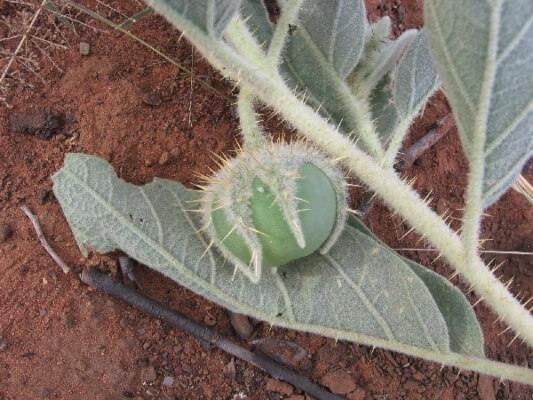
Source: delta-intkey.com
Simply known as the Wild Tomato, the fruit of Solanum phlomoides is cased in a spiny wrapping as it develops, which opens to reveal a bright jade-coloured berry.
The floppy, undefined leaves are soft and felt like in texture, and much thicker than most solanum, while the flowers are an intensely deep purple.
The thicker leaves are well adapted to arid conditions and hold plenty of moisture, making them easy to grow at home, but sadly it is very difficult to find seeds for these fascinating plants online.
They are found all over the North West coast of Australia, and very rarely seen anywhere else in the wild.
How to Grow Australian Bush Tomato
Bush tomatoes grow in arid conditions in the wild and are well adapted to cope with high temperatures. However, growing them at home allows for some adaptations to their growing conditions which can improve fruit production, and even prolong the life of these plants, which are after all, very closely related to common tomatoes.

Source: bushtuckershop.com
Growing Bush Tomato Outdoors
Bush tomatoes are best grown outdoors in most of Australia, with climates similar to their natural habitat, though garden soils are generally amended or improved from the arid desert sands.
Soil
Method one: Bush tomatoes can be grown in pots or in the ground, but will need plenty of drainage. To prepare a raised bed for bush tomatoes, dig a wide trench, and fill the base with grit or gravel to provide fast drainage.
On top of the gravel, mix garden soil (ideally sandy) with plenty of organic matter, such as garden compost or rotted manure. This mixture holds some moisture, while allowing excess water to drain off.
It also provides a huge nutrient boost to these plants that they would rarely get in the wild. Oddly, going against nature here is a big benefit to the plants, and usually results in a bumper crop.
Click here to see our review of the best raised garden beds and planter boxes for 2023.
Method two: The downside of adding organic matter is that it holds moisture through winter, which can foster soil borne fungus or even freeze the roots.
An alternative method is to stick to well-drained soil, and water regularly through the growing season. Higher irrigation will still improve the yield compared to wild plants but allows for drier soil over winter.
The lower nutrients of this method can be balanced out with a liquid seaweed fertiliser (refer to our review of 3 liquid seaweed ferlisers here) once a week when flowers start to form in early summer.
Spacing
Space bush tomatoes at least 1m apart. Solanum aviculare should be given its own bed, with at least 1.5m on either side of the plant to allow for the rapid growth, and mature size of over 3m tall and wide.
One of the worst things you can do for any tomato plant is to plant too densely. Poor airflow promotes bacteria and holds water in place on the leaves as the sun can’t directly heat and evaporate it after rainfall.
Research the size of each plant, and provide its full size, plus 30cm on either side so air can pass when it is mature.
Water
Bush tomato irrigation is tricky, as they are adapted to arid conditions, but like all solanum crops, water produces larger fruit and more of it. Watering bush tomatoes is all about balance, so from day one, you should be watching the soil closely to make sure it is never damp at the surface.
Try to keep soil moisture regular and consistent to aid the production of fruit.
Light
Plant Australian bush tomatoes in full sun. Partial shade, shade, or part sun will be inadequate, especially for the fluffy-leaved or thick-leaved varieties, which hold moisture in every leaf, and will therefore suffer from raised humidity in any shade.
Find a warm, sunny spot in the garden where these plants can grow for several years.
Humidity
Low humidity is very, very important to bush tomatoes. While standard tomatoes require low-medium humidity, bush tomatoes are adapted for arid conditions, and their foliage is more susceptible to fungal problems in humid conditions.
Planting outdoors generally avoids high humidity, but it’s also important to never water the leaves directly and target water at the base of the plant to avoid splashes.
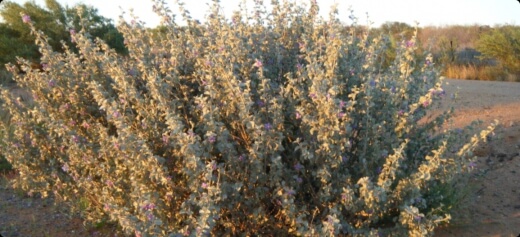
Source: agric.wa.gov.au
How to Grow Bush Tomato Indoors
If you want to regulate your tomato growing conditions in cooler southern regions, aim to grow bush tomatoes indoors, or in a greenhouse.
Follow the instructions above for growing bush tomatoes outdoors, but provide good aeration, keep humidity to a minimum, and water several times per week in free draining soil, disposing of excess water from trays underneath your bush tomato plants.
How to Propagate Australian Bush Tomato
Bush tomatoes germinate erratically and do not take well from cuttings. As woody shrubs, they grow well from root fragments and often clone themselves in this way in the wild.
Growing bush tomatoes from root fragments is similar to propagating by division. Essentially, dig up as much root as possible, and replant it in well-drained soil.
Aim for roots with independent growth attached where possible. Keep these young plants well-watered until they establish in a new location.
To grow bush tomatoes from seed you need to expose them to smoke. This can be done by using smoked vermiculite, or by directly exposing them to hot or cold smoke from a smoker or BBQ.
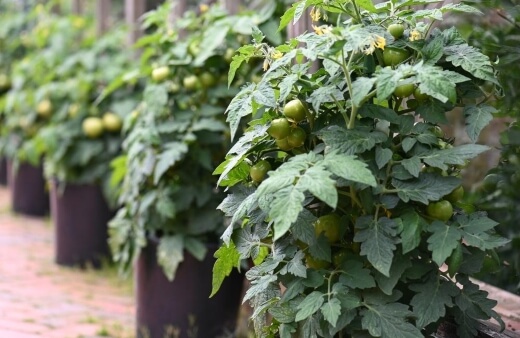
In the wild, the seeds germinate readily after a bush fire and are triggered into growth by the heavy rains that typically follow fires in central Australia.
Plant seedlings in individual pots with smoked vermiculite and garden compost. Keep the seeds moist until they germinate, which can take up to 28 days.
When plans are large enough to handle, prick them into larger containers, and plant into the garden when they have established roots. Leave 0.5-1m between plants and keep them well watered while they establish.
Australian Bush Tomato Pests and Diseases
Most native plant species are resilient against native pests and diseases, but thanks to the prevalence of Solanum species from the Americas throughout Australia, there are many imported diseases that affect bush tomatoes.
Similarly, bush tomatoes are widely able to cope with most pests in the wild, but grown in cultivation in our gardens a different range of mild climate pests is known to prey on their leaves.
Rutherglen bug
The Rutherglen bug, or Nysius vinitor, is a native flying insect which has four growth stages (larval, nymph, wingless adult, and winged adult). They have reddish-brown bodies and are around 3mm long.
They thrive in dense areas of foliage and are most active in winter and spring, but remain on bush tomatoes through summer.
They do not usually pose a significant risk to bush tomatoes, but severe infestations can cause damage to flowers and young leaves which turn yellow or distort due to overfeeding.
They are most likely on bush tomatoes in well-drained soil, so providing irrigation helps to reduce the problem.
Cowpea aphid / Silverleaf whitefly
Aphids and whiteflies are part of the same family. They feed on the chlorophyll produced by healthy new leaves as they emerge as growing tips in the spring or early summer.
Severe infestations can completely prevent new leaves and flowers from forming. To kill aphids and whitefly, spray the affected areas with horticultural oil – an organic pesticide which acts as a deterrent for future pests too.
Spray horticultural oil in the late afternoon when the sun is lowest. This prevents leaf burn and allows moisture to dissipate or drip away without humidity building.
Late afternoon treatment also reduces the risk of accidentally spraying beneficially pollinating insects.
Check out our guide on how to identify and get rid of whiteflies for more info.
Cutworms
Cutworms will literally cut seedlings off at their base, and are most problematic on young tomato plants (bush tomatoes included) at the seedling stage, though they can still affect mature plants by feeding at the base of plant stems.
While this won’t affect most arid crops, irrigation and warm weather can promote southern blight, which takes hold on the damaged lower stems of all Solanum species after heavy rainfall.
Budworms
Budworms burrow into developing fruits as they begin to ripen, causing damage and making the fruit inedible, often mouldy. Check your crops regularly for signs of burrowing in fruit.
Remove any damaged fruit, and check for the larvae around the rest of the plant, spraying with an organic insecticide to prevent further problems.
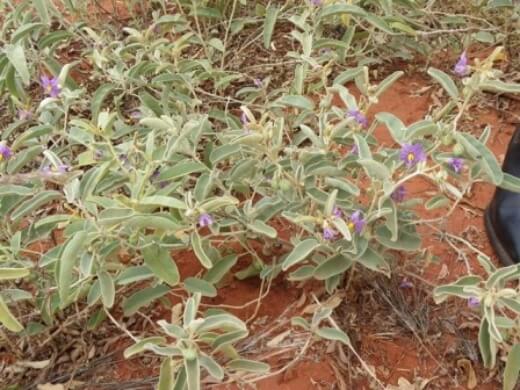
Source: agrifutures.com.au
Blight
Like any solanum, blight is a problem for bush tomatoes. There are three types of blight; early blight, late blight, and southern blight. Each is just as damaging as the next.
Early blight is identifiable from target-shaped rings, brown in the centre, with yellow rings, followed by brown rings. These usually join up across the whole leaf later on.
Late blight is sporadic and generally seen as brown patches with uneven shapes and yellow lesions around each mark. Southern blight starts at the base of the plant, and severe infections appear as white mould covering the lowest parts of the stem, building to black rot growing upwards.
All blights should be treated by removing the affected areas, and anything above them. Something this means the whole plant, but it’s essential for the health of the overall crop.
Verticillium wilt
Verticillium wilt looks very similar to late blight, growing in uneven lesions with brown patches and yellow borders. The key difference is that verticillium wilt develops in a V-shape from the leaf margin (usually the tip).
Remove affected areas and treat with a general organic fungicide in the evening.
Fusarium wilt
Fusarium wilt is a soil-borne fungal disease that blocks the xylem (the water-carrying cells) in solanum plants. The results are fairly rapid browning of the leaves, which wilt evening across the plant.
Fungicides are usually ineffective, so remove any affected growth and burn it before it spreads to other plants.
Root rot
Root rot is a general term that covers many different pathogens, but the most common cause is overwatering. Waterlogged soil around the base of bush tomatoes prevents the roots from taking up nutrients, and the stagnant water around the roots harbours bacteria or fungal spores, which overtake the root system.
If you notice leaves turning dry, but the soil is moist, root rot is usually the cause. Dig up the plant, and cut out any dead or diseased roots, then replace the soil, and replant having watered the ground with a fungicide.
Australian Bush Tomato Frequently Asked Questions
Can you eat Australian bush tomatoes?
Not all species of Australian bush tomatoes are edible, but the most common are safe to eat. When ripe, they turn a deeper yellow or orange colour, but it’s not just about eating, they’re worth growing in any Australian garden for their writhing stems, silvery Mediterranean foliage, and pops of purple flowers.
Which bush tomatoes are edible?
There are eight species of Australian bush tomato that are edible, and all are worth growing at home: S. aviculare (Kangaroo apple), S. centrale (Desert Raisin), S. chippendalei (Bush tomato), S. diversiflorum (Karlumbu), S. ellipticum (Potato bush), S. laciniatum (Kangaroo apple), S. orbiculatum (Round-leaved solanum), S. phlomoides (Wild tomato).
What did aboriginals use bush tomatoes for?
Australian bush tomatoes were used by aboriginals as a winter food source. While they ripen through summer and early autumn, they can be dried and turned into a paste, which stores well for winter when fresh crops weren’t available.
Can bush tomato be eaten raw?
Australian bush tomatoes don’t need cooking or drying to be eaten and have a sweet flavour with an earthy base when eaten straight from the plant. However, they taste far, far better when sun-dried, or oven-dried, taking on a deeper flavour and more intense chewy texture for snacking, or slicing into sauces.
Are Australian bush tomatoes the same as American Bush tomatoes?
Australian bush tomatoes are a distinct group of species, but all form part of the solanum family – one of the only solanums to have evolved outside of South America.
They grow as tender perennials around the world but are truly perennial in their native Australian habitat.
What does a bush tomato look like?
If you are foraging for bush tomatoes, think again, as they are a protected species, and harvesting any fruit or seeds from the wild is against the law in most states.
However, if you’re simply trying to identify a plant, look for long silvery foliage, on soft yellow stems. The lower part of the plant will be pale but woody, and any flowers are purple and star-shaped, with bright yellow centres.
Where can a bush tomato be found in Australia?
Australian bush tomatoes can be found growing wild throughout the Northern Territory, Western Australia, and northern parts of southern Australia. They like dry, hot summers, and excellent drainage, and are more common in open ground with no other herbaceous competition.
Should you prune a bush tomato?
Australian bush tomatoes can be pruned, but don’t need it. Pruning will reinvigorate your plant, and if there is a risk of frost, can make it easier to store over winter, but there is no real reason to routinely prune Australian bush tomatoes.
What does a bush tomato taste like?
Australian bush tomatoes have a powerful earthy flavour that is slightly bitter when raw, and almost caramel when dried. They tend to have a firmer flesh than common tomatoes and tougher skins, which is when they hold up so well to drying, either on the vine or in a low oven.
When should you eat bush tomatoes?
You can eat fully ripe bush tomatoes raw, but they have a bitter flavour and are much better dried on the bush until they start to resemble a sultana. For foraging, more of the toxic compounds in bush tomatoes are lost with fully ripe, dried fruit, so it’s a safer time to pick them.
How long does it take to grow bush tomatoes?
Bush tomatoes will usually fruit in their first year, but don’t reach their ultimate height for two or more years. Growing bush tomatoes from seed takes time and very specific conditions, so start them early in the season for a crop in the first year.
Interested in growing other tomatoes in your garden? Check out our growing guide to find out which varieties grow best in Australia.
Wrapping Up Our Bush Tomato Guide
Bush tomatoes might be a difficult crop to get started with, but once you know how to grow them they will crop year after year, and require very little attention.
Growing your own Australian bush tomatoes is far more reliable, and much safer than foraging, as plants can easily be mistaken for poisonous species within the same genus.
It’s also illegal in most states to harvest wild crops or bush tucker, so growing bush tomatoes yourself is a good way to keep a reliable supply of these unique native fruits.
Published on January 13, 2023 by Lorri Hopkins
Last Updated on August 26, 2025




